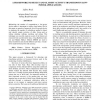Free Online Productivity Tools
i2Speak
i2Symbol
i2OCR
iTex2Img
iWeb2Print
iWeb2Shot
i2Type
iPdf2Split
iPdf2Merge
i2Bopomofo
i2Arabic
i2Style
i2Image
i2PDF
iLatex2Rtf
Sci2ools
ICMCS
2009
IEEE
2009
IEEE
A framework to detect and classify activity transitions in low-power applications
Minimizing the number of computations a low-power device makes is important to achieve long battery life. In this paper we present a framework for a low-power device to minimize the number of calculations needed to detect and classify simple activities of daily living such as sitting, standing, walking, reaching, and eating. This technique uses wavelet analysis as part of the feature set extracted from accelerometer data. A log-likelihood ratio test and Hidden Markov Models (HMM) are used to detect transitions and classify different activities. A tradeoff is made between power and accuracy.
Related Content
| Added | 19 Feb 2011 |
| Updated | 19 Feb 2011 |
| Type | Journal |
| Year | 2009 |
| Where | ICMCS |
| Authors | Jeffrey Boyd, Hari Sundaram |
Comments (0)

